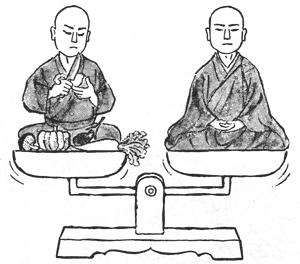 I was pleased this morning as I reviewed the comments to my recent posts about Soto Zen going to hell. Seems like as real a cyber conversation as we’ve had in these parts. Not everyone agrees, of course, and sometimes feelings flare.
I was pleased this morning as I reviewed the comments to my recent posts about Soto Zen going to hell. Seems like as real a cyber conversation as we’ve had in these parts. Not everyone agrees, of course, and sometimes feelings flare.
One way to frame the disagreement is as a debate between inherent stability and full aliveness. As is often the case these days, Dogen is brought up as a proponent of inherent buddha nature with a slight twist – there is no enlightenment apart from practice and its corollary, practice is itself enlightenment.
Was Dogen, then, the patron saint of passive Zen, as one tongue-in-cheek commentator says?
The above drawing (not mine), represents the active and passive aspects of what Dogen taught (e.g., “Instructions for the Cook” vs. “Zazenshin”) and reflects the actual practice of Soto Zen. Obviously, there are the active (work) and passive (zazen) sides of training. However, for Zen activity to be fully alive, the activity must spring from stillness. For the practice of stillness to be fully alive, interiority must be dynamically hopping along.
I like the drawing above, but from the view I’m expressing here, I’d like the two monks to be much closer. It isn’t about balancing two things but about the two aspects entwined and hopping along together, sometimes dangerously close to falling down, sometimes falling down. And then, pushing off the great earth, getting up and getting going again.
The form of zazen and the precepts, for example, are the containers for full aliveness, the ground rules for full-out boogie, optimally unfolding full aliveness. Without the intimate engagement of both aspects, practice is either boring and repressive or crazy and dangerous. The beauty of Dogen’s expression is how he points to full aliveness in stillness, still within full aliveness.
This is akin to Suzuki Roshi’s pre-politically correct “Hinayana practice with Mahayana spirit – rigid formal practice with informal mind.”
So this conversation isn’t about authority, but about what Dogen wrote 750 years ago that can inform our practice-enlightenment now and especially for the next generation and beyond. The important point, then, is to take up the teaching and experiment with it … enjoying a good rant from time to time too. The old bugger certainly did.
Different people will come up with different results as they use the body-mind to test the teaching. No problem. At the same time, that doesn’t mean that they’re all equal in power to illuminate one little corner of the world, as they say.
If it could be definitively demonstrated that Dogen totally favored one side or the other … well, ho hum. And that does seem to be the drift in contemporary Soto Zen – a rush to institutionalize, regulate, and normalize – making Zen safe and dull and utterly devoid of challenge and freedom.
A Zen teacher friend recently mentioned to me that when he read through the survey results of Soto Zen teachers that I’ve been groaning about, he found that when there was 60-70% agreement on some point, that he too almost always agreed. After our conversation, it occurred to me that I wished I said to him, “Yes, exactly the point. Ask safe questions tending to the norm and that’s the answers that you get.”
After 30-some years of study and practice, it’s my provisional view that Dogen was not advocating silent illumination or passivity. He was a creative. In fact, that Dogen did not advocate quietism makes him relevant today and is what keeps me coming back to his vivid expression of practice where the active and passive elements are in intimate conversation, with neither aspect dominating the other.
Even in his early years, when he was about 30, Dogen junked the “silent illumination” framing of zazen for the much more active “self-enjoyment samadhi.” Later it became “the acupuncture needle of zazen” as well, of course, as “dropping body and mind” and “earnest, vivid sitting.”
In the early period, as I was saying, it seems to me that he hadn’t fully resolved the nasty moral and practice implications of the original enlightenment teaching (“It’s all good” and “whatever” and “just sit”) that were vogue in his day. Here’s a passage from the “Self Enjoyment Samadhi” section of “Bendowa” with my comments inserted:
There is a path
(emphasizing the relative world with a beginning, middle and end)
through which the unsurpassed, complete, perfect enlightenment of all things
(emphasizing the fundamental, giving possession of perfection to each of the myriad things with or without path)
returns
(the 10,000 dharmas advancing to confirm the self)
to the person in zazen, and the person and the enlightenment of all things intimately and imperceptibly assist each other.
(the practitioner boogieing with the buddha).
Therefore, this zazen person
(this person who has become a zazen person, but not necessarily the person who does not practice, intimately entwines with buddha)
without fail
(stay with it practitioners, you are doing it!)
drops off body and mind, cuts away previous tainted views and thoughts, awakens genuine buddha-dharma, universally helps the buddha work in each place, as numerous as atoms, where buddha-tathagatas teach and practice, and widely influences practitioners who are going beyond buddha, thereby vigorously
(the bold highlight that this dance is not passive)
exalting the dharma that goes beyond buddha
(ordinary being and buddha together go beyond buddha).
Dogen’s creative burst of dharmic, koanic fluency during his early 40’s in Shobogenzo fascicle after fascicle goes beyond his early work in intensely wrestling practice-enlightenment, active-still, sacred-profane. More about that in future posts. I use the above because it is often cited to support the all-zazen-is-enlightenment view while the meaning is considerably more nuanced.
Dogen this and Dogen that. How will I live? How will you live?
Myotai Treace once said, “You can’t live a bunny life and write tiger poems.”
What is the self?











